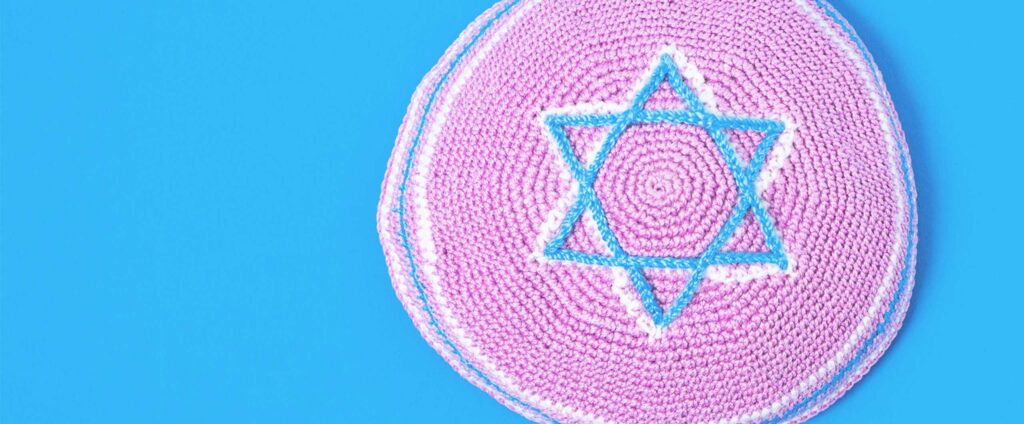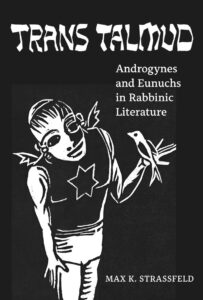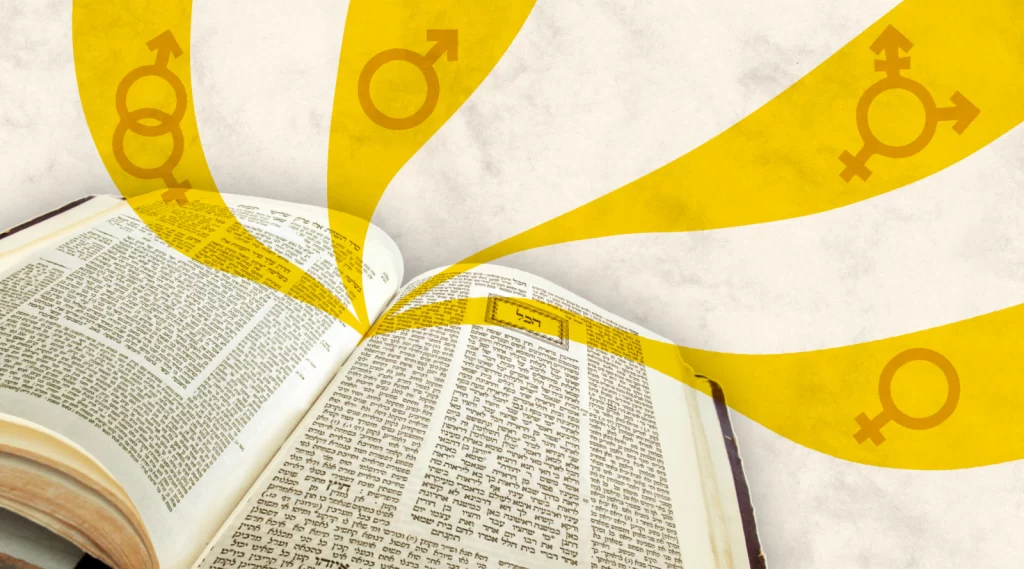Turning to the Talmud to Find Gender Diversity that Speaks to Today
The Talmud’s eight genders offers important insights about Jewish views on the existence of bodily gender diversity

(Image source: Shutterstock)
When I google “gender” and “Talmud,” I find countless articles that enumerate the eight (or seven or six, depending on how the list-maker is counting) genders discussed in the Talmud, a Jewish body of literature that dates from approximately the first six centuries of the common era. The rabbis’ writings in the Talmud about these multiple genders have created a swell of popular interest in Jewish legal sources. Discussions of the multiple kinds of gender possibilities in rabbinic literature are in a mixture of Hebrew and Aramaic (with the occasional loan word thrown in from other languages). These sources are difficult to understand and require training to be able to read them; even just being able to read Hebrew fluently will not be enough to parse rabbinic arguments. And traditionally, these texts have only been taught to men. It is a recent development that there are venues for women to learn the skills needed to access these sources. Typically, the study of the Talmud takes place in conservative environments and is segregated by sex; it is only very recently that there are schools and classes that specifically welcome trans, queer, and nonbinary students.
Since publishing my book, Trans Talmud: Androgynes and Eunuchs in Rabbinic Literature, I have been invited to be a guest on podcasts, teach at synagogues and rabbinical schools, and have been interviewed about my work. Given that I wrote a dense academic book about one of the more technical areas of law in rabbinic literature, why has there been so much interest? What is it about eunuchs and androgynes in Jewish legal texts that is attracting so much attention?
 In order to answer that question, I want to first introduce the figures of eunuchs and androgynes to give you a sense of the many different kinds of bodies that the Talmudic rabbis discuss. I use the English words “eunuchs” and “androgynes” as short hand for a variety of different terms that the rabbis employ to describe bodily gender diversity. The rabbis did not invent all of these terms. For example, their word for eunuch (saris) is found in the Hebrew Bible, which pre-dates rabbinic literature. But the rabbis had a more expansive understanding of what a saris/eunuch could be. For the rabbis, a eunuch could refer to a man who undergoes changes to his genitalia, including castration. But a man could also be born as a eunuch. Being a “born eunuch” meant being born with bodily differences that would preclude the ability to reproduce as an adult. Today, we might label that person intersex. Saris/eunuch, therefore, functioned as an umbrella term; it could refer both to people who were born without reproductive capability, and those who become unable to reproduce.
In order to answer that question, I want to first introduce the figures of eunuchs and androgynes to give you a sense of the many different kinds of bodies that the Talmudic rabbis discuss. I use the English words “eunuchs” and “androgynes” as short hand for a variety of different terms that the rabbis employ to describe bodily gender diversity. The rabbis did not invent all of these terms. For example, their word for eunuch (saris) is found in the Hebrew Bible, which pre-dates rabbinic literature. But the rabbis had a more expansive understanding of what a saris/eunuch could be. For the rabbis, a eunuch could refer to a man who undergoes changes to his genitalia, including castration. But a man could also be born as a eunuch. Being a “born eunuch” meant being born with bodily differences that would preclude the ability to reproduce as an adult. Today, we might label that person intersex. Saris/eunuch, therefore, functioned as an umbrella term; it could refer both to people who were born without reproductive capability, and those who become unable to reproduce.
In addition to the male eunuch, the rabbis also had a category of female eunuchs, called the aylonit: a woman born with bodily differences that prohibit her from bearing children. She is the counterpart to the born male eunuch.
The rabbis also describe different types of bodies that I group under the English term “androgynes.” One kind of androgyne was someone with two sets of genitalia; we have early texts that describe them as able to menstruate and produce seminal emissions. Another kind of androgyne was called a tumtum, which refers to a person who has an indeterminate gender. Descriptions of the tumtum differ, but some texts describe them as having a flap of skin that obscures their genitalia.
All of these different figures appear prolifically in rabbinic literature. In Jewish legal sources, gender is frequently a determining factor when ascertaining legal obligations. For example, there are many laws that specifically govern the ritual behavior of men, such as how many times a day they must pray. Within the system of Jewish law, the rabbis debate how to handle the status of eunuchs and androgynes. Are eunuchs obligated to participate in marriages that are contracted specifically for procreation? Likewise, what are the requirements and prohibitions for circumcision when an androgyne baby is being circumcised?
Rabbinic sources do not always cast eunuchs and androgynes in a positive light. Some strains of rabbinic debates place more restrictions on eunuchs and androgynes than they do on men and women.
Still, the rabbis never question that a variety of different kinds of nonbinary bodies exist in the world. And for some rabbis, being born into a particular body is akin to saying that a person’s body was created by God. We see statements that assert that the born eunuch was created by the “hand of heaven.”
In my book, I argue that the inclusion of eunuchs and androgynes in Jewish traditions has two opposite effects: androgynes create nonbinary space in Jewish law, and they also create more opportunities for the rabbis to regulate gender and sexuality. For example, the rabbis debate androgyne’s sex lives. Is an androgyne “man” enough that when a man has sex with an androgyne it violates the biblical prohibition against men having sex with men? The rabbis are not able to offer a definitive answer. Since the rabbis cannot fully decide the gender of androgynes, these figures haunt the text, creating defacto nonbinary space in the legal tradition. Paradoxically, the fact that the rabbis are unsure about the androgyne’s gender does not save the androgyne from being subjected to sexual prohibitions. And it means that the rabbis spend a considerable amount of time contemplating the anatomy of androgynes and androgyne sex. So, at one and the same time, androgynes both create nonbinary space in the tradition, but also enable the rabbis to extend their policing of sexuality and enact more surveillance of gendered bodies.

(Image source: Flickr)
While the texts about eunuchs and androgynes are inherently interesting to me, what I find most inspiring is the way the rabbis organize sex and gender differently. Categories of androgynes and eunuchs do not correspond to the division we draw today between intersex and trans people in the United States. While it is possible that some of these figures, like the born eunuch, would be understood as intersex today, the rabbis grouped together those who were born with bodily differences and those who acquire bodily differences under the same heading. For them, the defining feature of a eunuch was that they could not bear children, whether they were born infertile or became infertile, and whether they were men or women.
These historical differences are significant precisely because of the way binary gender is considered natural and normal today. In the United States we regulate, operate upon, and police trans and intersex people when their sex or gender does not meet binary expectations. Rabbinic literature provides an example of a cultural framework where nonbinary bodies are a part of creation. If our current systems of sex and gender are historically and culturally contingent, then there is potential for a more expansive understanding to emerge in the future.
As a scholar who studies these categories, and believes that they have not received enough attention in mainstream Jewish communities or in the academy, I am pleased by the growing popular interest in androgynes and eunuchs. While I do not think these texts present celebratory, or even (sometimes) positive, depictions of eunuchs and androgynes, I do think they provide an important resource for re-envisioning Judaism.
***
To return to the question with which I began, I believe that there are at least two answers as to why eunuchs and androgynes in rabbinic literature are suddenly seeing mainstream popularity, despite the fact that they are found in technical and often uninspiring sources. On the one hand, the popularity of eunuchs and androgynes directly correlates to the strength of these new movements in the study of the Talmud. The reason that mainstream Jewish and non-Jewish audiences are suddenly discovering these sources is because of the painstaking work of activists who are bringing those traditions to the fore.
On the other hand, the very popularity of eunuchs and androgynes in rabbinic literature also indexes a much darker political moment – specifically the rise in anti-trans legislation. Lourdes Ashley Hunter, national director of the Trans Women of Color Collective, has said: “Every breath a Black trans woman takes is an act of revolution.” She is calling out the way the current political climate violently targets Black trans women, and BIPOC trans people more generally, often to devastating effect. In this environment, survival is an act of resistance.
Recent legislation has primarily targeted transgender youth: there have been bans on trans teens in sports, bans on trans-affirming medical care for adolescents, and attempts to regulate public facilities like restrooms. Some of these legislative efforts have been directly linked to Christian evangelical or Christian nationalist organizations, which make the claim that religious freedom necessitates the freedom to discriminate against trans people. At the same time, there has been a rise of accusations that transgender people are “groomers,” implying that trans and queer adults are actively recruiting vulnerable youth.
“Groomer” rhetoric presents transness as a kind of disease spread by calculating trans adults. This accusation has been connected to recent legislation. The governor of Florida’s press secretary, Christina Pushaw, characterized Florida’s “Parental Rights in Education” law as an “Anti-Grooming” law. The left dubbed this the “Don’t Say Gay” bill, arguing that it prevents educators from addressing sexual orientation and gender identity in the classroom. This not only harms trans and queer youth, but it also can be interpreted to ban discussions of sexual orientation and gender identity even when it pertains to a student’s family. Pushaw argues that supporters of queer and trans education in schools are themselves “groomers,” or supporters of groomers, suggesting that even teaching students about the existence of queer and trans people damages minors. These concerted anti-trans efforts have led historian Jules Gill-Peterson to describe such legislation as an attempt to build a “cisgender state.”
Taken together, the legislation to erase trans youth and the stigmatization of intergenerational contact in trans communities cuts trans youth off from their histories. By situating trans youth as a “recent” phenomenon that must be explained, we are denying youth their intergenerational inheritance. This is nothing less than a concerted effort to suppress the kinds of knowledge building and the passing down of survival skills that has traditionally taken place in trans, queer, and intersex communities. Targeting youth is an attempt to erase a trans future.
It is in this context, then, that we must understand popular interest in centuries-old texts about androgynes and eunuchs. In a climate where legislators are claiming “religion” requires them to discriminate against trans people, trans and intersex Jews are turning to historical sources to present a different narrative. Trans Jewish theologians are reinterpreting the Hebrew Bible. Trans artists have depicted Jewish legal traditions about androgynes. And trans and intersex rabbis have turned to eunuchs and androgynes to argue that nonbinary gender has a history within the Jewish tradition. In answer to the claim that religion hates trans people, the existence of eunuchs and androgynes in canonical religious texts is powerful. That religion has an awareness of nonbinary existence threatens the current conservative narrative.
I should be clear that I do not believe the Talmud’s eunuchs and androgynes are literally trans and intersex, which are modern categories to explain gender and sex differences. I also do not think trans people should be called upon to justify their existence by turning to history. Still, history and traditions remain a powerful tool in countering anti-trans narratives in this current political climate.
Historically, the Talmud has been denied to marginalized Jews and only studied by men. The recent activism of BIPOC Jews, trans and queer Jews, and feminist Jews, has dramatically widened who has access to rabbinic literature. The creation of alternative venues to study the Talmud is a corrective to the way the tradition has been interpreted by and for straight, cisgender men. BIPOC, trans, intersex, feminist, and queer rabbis, activists, and artists have been reinterpreting and reinventing the tradition by reading from the perspectives of those who were deliberately excluded from it.
These sources, even as they are problematic at times, are the inheritance, the yerushah, of intersex, trans, and queer Jews. They will be the ones to use these sources to transform contemporary Judaism and change the negative relationship between religion and trans people in the future.
Max Strassfeld is an Associate Professor of Religious Studies at the University of Arizona. They are the author of Trans Talmud: Androgynes and Eunuchs in Rabbinic Literature, published with the University of California Press.